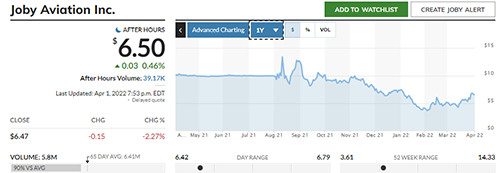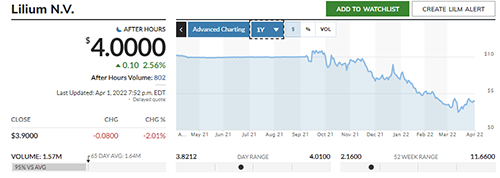
A version of this article first appeared in our free newsletter, to subscribe click here.
It has been a difficult few months for eVTOL. Front runner Joby Aviation suffered the loss of a prototype aircraft. Thankfully the aircraft was being remotely piloted at the time.
Outside of the industry it is not understood how disruptive the loss of a prototype aircraft can be. It is not like the loss of production aircraft. In production the aircraft are being manufactured in relatively high numbers and high frequency at a reasonable cost. In pre production each aircraft is eye wateringly expensive to produce and will take months if not years to manufacture and make ready for flight.
If the production cost of the Joby Aircraft is, say, $2M USD, the cost of each prototype in terms of bill of materials, labor and other processes could be $20M USD. This cost is low compared to the extension of the development program. If the new aircraft takes one year to produce and fly it is safe to assume you will have to extend the program by 12 months. As you cannot fire all of the development staff and rehire when the aircraft is ready, you have to carry the cost of the development staff for an additional 12 months. This can cost anywhere between $50M and $100M USD.
So just in cash requirement terms, this event may cost the Joby program up to $120M USD. There is also the loss of investor confidence and customer confidence to factor in and these may create an additional cost greater than the direct dollar value.
Shortly after this event several negative articles were published that attacked the credibility of another eVTOL industry leader, Lilium. There are several serious allegations in this article. I will not go into them in great detail but they are typical of general criticisms of eVTOL ventures – ignoring credible negative criticisms, a lack of relevant experience at the leadership level and the use of potentially optimistic battery energy density numbers to support production performance numbers.
As both Lilium and Joby are now publicly traded the investor confidence in these companies can be easily seen:
https://www.marketwatch.com/investing/stock/joby

https://www.marketwatch.com/investing/stock/lilm

This performance can be compared to the market as a whole:
https://www.marketwatch.com/investing/index/nya

Not surprisingly investor confidence in Joby and Lilium has been falling since their IPO. Bear in mind that these companies are the eVTOL sector leaders and should represent the best in the sector.
The unreality of the eVTOL sector is not helped by metrics such as these https://aamrealityindex.com/. The AAM reality index produced by SMG consulting “…helps assess the industry entrants’ progress toward the delivery of a certified product at mass scale production.”
In reality it is a league table where rankings have an almost direct correlation to the amount of money raised. It is not clear what reality they are referring to – I have to assume it is an alternative one.
Raising money is not always the solution and eventually it will become the problem. Investment has to be repaid. The more money you raise and the more you spend in development, more money has to be generated in order to compensate investors when you get to production.
The flip side to this problem is that just spending money on development doesn’t mean you get a better aircraft that will justify the price or create the demand these projects are predicting – and an excess of expenditure typically means the opposite. Famous examples such as the Sino Swearingen/Emivest/Metalcraft SJ30, the Eclipse 500 and the Beech Starship are all examples of excessive overspend resulting in a product that failed to meet market or commercial expectations (or both) and eventually failed.
So what projects are more likely to be successful? The factors that will influence actual commercial success in the long term are:
Minimize expenditure: The more money you spend the more you have to recoup. Also, giving engineers a lot of money to play with likely will not drive them to the simplest, cheapest, most reliable and most elegant solution to the problem
Simple Design and Existing Technology: See above – inherent aerodynamic instability and lots of moving parts means complex software control, thousands or millions of potential failure modes with the chance of many more catastrophic outcomes that all need mitigating. Basing all of this on a power storage medium that is at a preliminary research stage is not going to help achieve commercial success..
Reliance on existing markets: Who will buy your product? How much will they buy? What price will they pay? Creating an impossibly complex aircraft by spending an astronomical amount of money does not mean anyone will actually buy it. Or at least not in the thousands of units per year that your business plan requires…….
Profitable at sales level of 100 aircraft per year or less: See above – what happens in the urban mobility revolution turns out to be as real as the Fyre Festival or the Millennium Bug? Can you compete as a General Aviation product? How many orders of magnitude are your required sales numbers in error? Can you tempt Pilatus PC12 or Robinson R66 customers to buy your product?
As eVTOL projects see their wildly optimistic initial project milestones disappear in the mists of the distant past and the date of their possible market introduction project forward into a wildly uncertain future, what is really going to happen?
The answer is simple. Anything that does not adapt to the harsh reality of the universe will eventually become just another cloud of historic entropy and exist only as a passing entry on the resumes of a few engineers.
The harsh reality of the universe:
- Batteries force you to fly impossibly short missions with unusable load fractions.
- The Urban Mobility market makes no sense. It does not and will not exist.
- Raising large amounts of money creates a millstone for your neck that will eventually sink you.
Net Zero, the greening of aviation, sustainable skies, carbon free flight and other slogans and political policies are not going to pay your investors back. Sucking more investors in to push the inevitable day of reckoning further into the future can only continue for so long. There is a name for that business model.

For a few hundred million dollars, it is hardly appropriate any more to start putting bits and pieces together to make a physical prototype. For “solar system colonization” multiply that by a million to say “hundreds of trillions of dollars”. Those kinds of investments for the human species cannot, should not, be done by termite algorithms – every small group adding found bits and pieces to some large, un-designed edifice termite mound. The human species, on a global scale, over decades and centuries behaves like a swarm, nothing planned. All hunch, intuition, instinct, evolution. Dirty, inefficient business.
So you want electric flight? Then don’t use acronyms, say “electric air planes” or “electric space ships”. Every tiny millisecond of human processing needed to understand something has to be trimmed away, so that billions of people, who have NOT memorized or learned the magic words and jargon in some new market – can learn what it is about, and begin to interact with quantitative investment models at scales appropriate for the human species.
Put your device and vehicle plans in forms where anyone or any groups with browsers can run the simulations. Most importantly have the bill of materials and realistic suppliers and cost always up to date. And have the financial impact model for society always visible, auditable, open to change and experiments, and tied to all related models.
The Internet now is stupid. It is not even that. It is a colony of ants or termites. Wonderful ideas and initiatives bubble up constantly. But because each group is trying to maximize things for a few individuals – the whole never gets anywhere. You have seen those human pyramids that stack humans several layers high. That happens with a thousand groups all working alone trying to adapt high energy density electron generators to flight, or manufacturing, transportation. They all get to what one individual group can do, but because they hoard and fight and quibble and compete, the whole never gets beyond a few layers.
Want tens of orders of magnitude? There are methods, but they all rely on perfect memory, reliability, and absolutely open and auditable processes.
I like the intent of Aerospace News. But having reviewed most of the Internet and human activities tied to it for the last 24 years, I can tell you it will fail. Because it is a COM. And because it is using “click and go to a whole new page, forgetting everything” paradigm from day 1 of the Internet. And, it is all “paper”. Words and images on a screen are no more powerful than ox blood on papyrus (or whatever they used for ink). This site, and hundreds of millions like it, all force the human readers to use their eyeballs and their own fallible and untraceable human memories. It is like that game of “telephone” or “whisper”, but with one child writing something down. The next child reads it by eyeball and their memory and writes it again. The next child reads it and compares to their memory and with their own limited skills, they write it down. In the children’s game, the last child blurts out what they heard, and it is ALWAYS horribly distorted and incoherent. “Paper” is like spoken words – when the transmission process requires long strings of human receivers and transmitters. Put humans in your critical decision processes and the system will ALWAYS fail. Maybe it can look OK for short time (a few decades, even a few centuries) but ultimately edifices constructed of human words will always fail. That is why there are no trillion dollar corporations, or the ones who strain to get there are bloated and failing and falling apart.
What you have to do it put the models and data in globally accessible places where everyone can see the whole easily, and can make changes to how they view and interact with it. Collectively, that can converge to globally reasonable solutions and opportunities for the human and related species.
site:abbottaerospace.com has only 4,730 entry points (Google search, 17 July 2022)
“electric vehicles” OR “electric vehicle” has 225 Million
“electric airplane” OR “electric airplanes” OR “electric planes” has 712,000 entry points.
If you want to have an impact in the world, you have to know your complete market. I would argue, that for all global issues and opportunities, that means you need a complete model of all reality. And such is possible now, enough to squeeze out a few more orders of magnitude for ANY topic, any technology. A best in world research group can do X. And the competing groups can do X/100. But the whole, working in a global open framework – can do 10,000X. Because there are so many groups doing nearly exact same things – all at graduate student levels at best. Or single entrepreneur levels at best. A corporation with a human based framework can grow to a few billions, then it ill collapse under its own weight – “How many humans does it take to fly an electric spaceship” – everyone, because human memories and attention and skills are all stored in human brain cells and habits. Memorized rules and steps learned from a blackboard and talking heads. Oral transmission of knowledge works for ancient tribes, but not for solar system colonies or interstellar projects. Not even for “covid”, or “fusion energy” or “climate change”.
Sorry, this topic really needs a book or website. But I only have time for a few comments and suggestions just now. It is so sad to see good people using the worst technologies for online collaboration. Kind of like seeing an engine where they did not spend time getting the seals right, so it leaks like a sieve. I have lots of websites, but I thought you might be interested in one about gravitational imaging arrays.
Richard Collins, The Internet Foundation